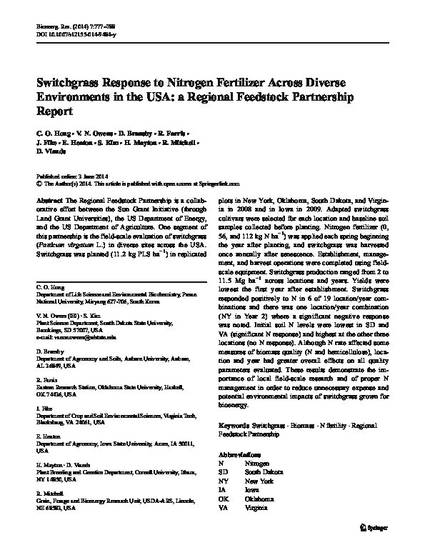
The Regional Feedstock Partnership is a collaborative effort between the Sun Grant Initiative (through Land Grant Universities), the US Department of Energy, and the US Department of Agriculture. One segment of this partnership is the field-scale evaluation of switchgrass (Panicum virgatum L.) in diverse sites across the USA. Switchgrass was planted (11.2 kg PLS ha−1 ) in replicated plots in New York, Oklahoma, South Dakota, and Virginia in 2008 and in Iowa in 2009. Adapted switchgrass cultivars were selected for each location and baseline soil samples collected before planting. Nitrogen fertilizer (0, 56, and 112 kg N ha−1 ) was applied each spring beginning the year after planting, and switchgrass was harvested once annually after senescence. Establishment, management, and harvest operations were completed using fieldscale equipment. Switchgrass production ranged from 2 to 11.5 Mg ha−1 across locations and years. Yields were lowest the first year after establishment. Switchgrass responded positively to N in 6 of 19 location/year combinations and there was one location/year combination (NY in Year 2) where a significant negative response was noted. Initial soil N levels were lowest in SD and VA (significant N response) and highest at the other three locations (no N response). Although N rate affected some measures of biomass quality (N and hemicellulose), location and year had greater overall effects on all quality parameters evaluated. These results demonstrate the importance of local field-scale research and of proper N management in order to reduce unnecessary expense and potential environmental impacts of switchgrass grown for bioenergy.
Available at: http://works.bepress.com/emily-heaton/49/

This article is published as Hong, C.O., Owens, V.N., Bransby, D. et al. Switchgrass Response to Nitrogen Fertilizer Across Diverse Environments in the USA: a Regional Feedstock Partnership Report. Bioenerg. Res. (2014) 7: 777. doi: 10.1007/s12155-014-9484-y. Posted with permission.